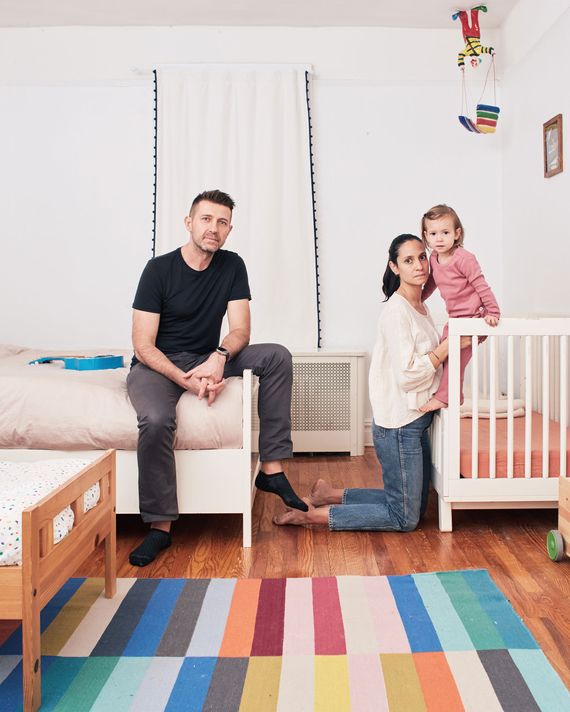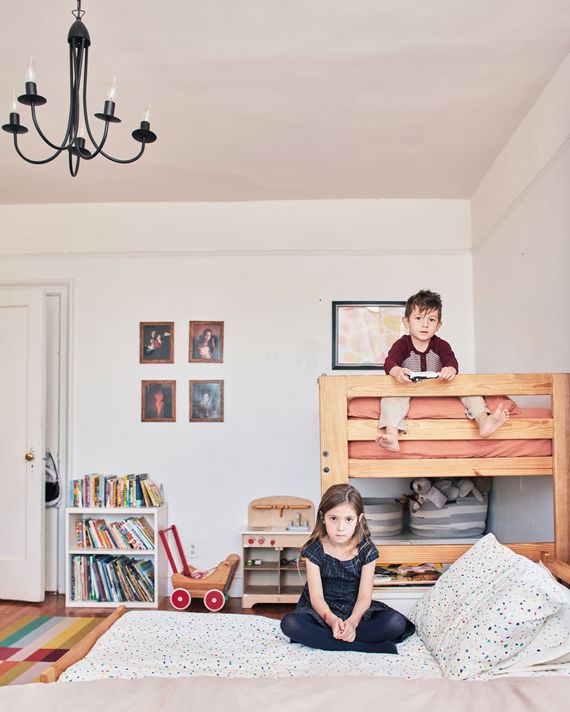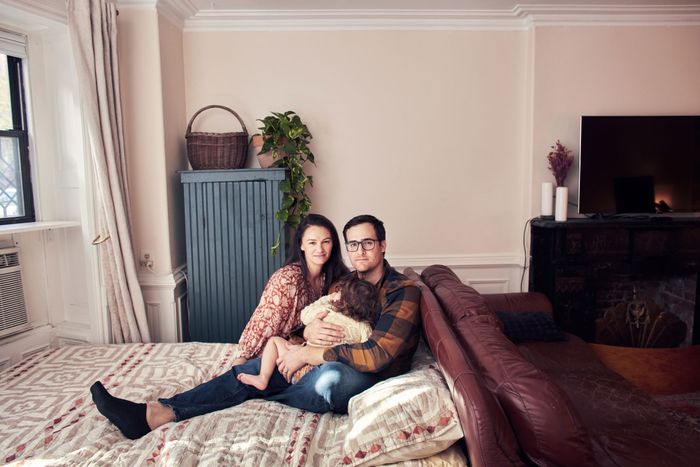NYC Families Who Choose to Live in One-Bedroom Apartments

This article was featured in One Great Story, New York’s reading recommendation newsletter. Sign up here to get it nightly.
At some point in the journey of becoming an “I love New York” parent, most of us find that our apartment feels too small and slowly come to terms with a harrowing real-estate truth: If we can’t find a bigger place within our budget, we’ll have to decamp to a suburb. But some parents with a knack for moving their furniture around find a third option: Stay exactly where they are and make do. With rents and interest rates stubbornly high, we talked to three families who have opted for one-bedroom apartments in sought-after neighborhoods and found out how they eat, sleep, play, and get space from one another.
Merie Sierra, Alex Sierra, Phoenix, age 6, and Cy, age 1 (pictured above)
850 square feet in Fort Greene
Merie and her husband Alex bought their one-bedroom shortly before they had kids, taken with the apartment’s 12-foot ceilings and the daylight that streamed into the living room every morning. “We figured at some point we could convert the bedroom into two,” Merie says. One week after they closed on the place, the pair found out Merie was pregnant. The true limitations of the floor plan only hit them about a year and a half later, when they tried to sleep-train their baby, Phoenix.
Convinced that having a baby who slept through the night mattered more than having their own room, the couple moved out of the bedroom and gave it to their baby, who had been sleeping in the living room. The swap meant giving up their king-size bed (“I didn’t even feel my husband beside me,” Sierra remembers wistfully). The corner of their living room had a slightly recessed niche and Sierra noticed that it would just fit a full-size bed, so they downsized their mattress and wedged a new smaller one behind their sofa on the floor. Once sleep training ended, the family decided to stick with the new sleeping arrangement (baby in the bedroom, parents in the living room) because they enjoyed having a living space free of toys. “Now Phoenix has all her toys in her room, so she can make a whole mess in there rather than making a mess outside in the living room, which drives me crazy,” Merie says.
Merie hung a gauzy curtain from the ceiling to further delineate the “bedroom” space as its own “little nook” and intentionally kept the bed low to the ground, dressed with plain bedding. “We have an open floor plan, so from walking into the apartment, I don’t want you to see my pillows from the door. Having just the pillows that we need and white bedding camouflages it back there, so it’s not an eyesore.” There’s no room for nightstands, so Alex puts his glass of water on the windowsill and Merie just puts hers on the floor. “I honestly don’t miss having nightstands,” says Merie. “It would just be another place for us to add clutter.” When visitors are over, Merie tucks any other night essentials in the bathroom or closet.
When their second child, Cy, was born, they initially positioned his crib in the living room near their bed for ease of night feedings, but, Merie says, “We all had to perfect our tiptoeing.” Then at around 6 months old, they tried placing his crib in the hallway outside Phoenix’s room, but that wasn’t any better. “My husband and I often have dinner late, and no matter how quiet we are, our son can hear us. He gives us a very cute but scary stare and we have to freeze until he falls back asleep,” says Merie. Now they’re working on getting him to sleep through the night in his sister’s room; that’s where his crib is now and where he plays during the day.
Other micro-adjustments that help with having two kids: Merie recently ditched her gorgeous, space-hogging sofa for a slender one so that the kids would have more room to run around the main living space, and she has come to rely on her local Buy Nothing group to unload kid gear the moment it’s been outgrown. She says she doesn’t mind living in a one-bedroom in Fort Greene. “[Our neighborhood] is like a little storybook. We see our friends every day walking down the street. We have playdates. We go for coffee. We go to the parks,” Merie says. “Obviously, we could go live in the suburbs and have a huge house, but what is there to do?”
Kelly MacDonald, Dan O’Brien, and ZZ, age 3
A garden apartment in a Park Slope brownstone
Photo: Frankie Alduino
Kelly and her husband Dan signed the lease on their one-bedroom having only seen it on a FaceTime tour. The Brooklyn couple had moved to a condo that Dan’s parents owned in Portsmouth, New Hampshire, to wait out the pandemic, but when their daughter was born in 2021, they felt drawn back to Park Slope. They wanted a two-bedroom apartment, but after six months of searching, settled for a one-bedroom, albeit with a small backyard. “The fact that we were going to be able to have a yard in New York City, which is hard to come by, was really exciting,” says Kelly. “We could envision ourselves in the space.”
Kelly says she has been surprised to discover that their space is functional with a kid. “We were going to try this out and see how it works,” she says, “and it really does.” Their bed is tucked into the living room’s bay window behind the couch, which serves as a room divider. “Sometimes, when we have guests over, they’ll leave and text us later asking where we sleep because they didn’t notice our bed,” says Kelly, who picked an Article bed frame that is a little lower than a standard bed but still allows for under-the-bed storage. A vintage wardrobe tucked into a nearby corner provides the storage typically found in nightstands. The parents’ clothes are all stored in the apartment’s sole closet, which is a walk-in. “Since the room is about 240 square feet, you don’t feel like you’re missing a part of the living room,” she says. “I think that’s one of the reasons why people don’t notice that our bed is back there.”
What happens if one partner needs a nap during the day, or one wants to stay up while the other goes to bed early? In those instances, whoever is still awake retreats to the kitchen, where they’ve managed to squeeze in a loveseat they found in their local Buy Nothing group. “We use it more than we thought we would,” says MacDonald. The couple also installed a sound-dampening curtain over the flimsy hollow-core door to their daughter’s bedroom. “It’s an old building,” she says. “It’s unbelievable how much you can hear throughout the apartment.”
Dana Demirer, Deniz Demirer, C., 6, E., 4, and R., 2
800 square feet in Bay Ridge


Dana and Deniz moved into their one-bedroom when Dana was pregnant with their first child, after learning a baby would not be welcome in the housing provided by Deniz’s artist residency at the Sheen Center in Manhattan. Each time their family has grown, they’ve added a bed to the bedroom, which Dana estimates to be about 300 square feet. These days, there’s a loft bed for the middle child (with toy storage and a play area underneath it), a single bed for their oldest, a crib for the baby, and a queen-size bed for the parents. Even with four beds, there’s room for a dresser, a glider, a small bookshelf, and a toy chest. (They also have a dresser in the foyer for extra clothes.) The advantage of the whole family sleeping in one room, along with the kids’ toys, is that the rest of their home functions no differently than a larger apartment would. The Demirers have a fairly grown-up-looking living room with a dining area. The distinct disadvantage is that the parents have to get creative to have any alone time.
The Demirers never thought they’d still be in the same place with three kids, but the family is not in a financial position to move within New York City right now. Whenever Deniz has a film project in the works, he rents office space outside of the home, and both parents use exercise as a way to escape. “It’s hard when my older kids want their ‘alone time’ with only one bedroom,” says Dana. “It’s usually the 2-year-old who they can’t get rid of.” She adds that the apartment felt the smallest one difficult week last year, when “we all went down like dominoes with the rotavirus.” But the couple acknowledge that it could be worse: Their neighbors across the hallway are a family of six in a one-bedroom.
With everyone sleeping in one room, the parents try to get the kids into bed at the same time, a routine that Dana describes as “mostly chaos.” After pajamas and teeth brushing, Deniz reads to the two older kids while Dana nurses and rocks their youngest in the glider. After the big kids are down, she transitions the baby to the crib. Right now, they’re trying to wean their youngest, who is still waking up and wanting to be nursed back to sleep, which means Deniz often retreats to the couch in the living room in the middle of the night. “Once she figured out how to get out of her crib, any sleep-training efforts were futile,” Dana says. “I’m her pacifier.”
Managing a small space, says Deniz, is mostly about a mind-set shift. “If we had more space, that space would just get cluttered up with more stuff,” he says. When the family traveled to visit Dana’s mom in California, they luxuriated in Grandma’s two-story home. “But we also realized that within a short span of time, that place just became trashed with toys too. And then you realize, ‘Wait a minute, this is the same: It’s just scale,’” says Deniz.
“Maybe we’ll look back on this time and kind of chuckle and miss those moments of such in-your-face, close proximity, constantly crawling all over each other,” says Deniz. “Space is great, and yes, you want to get away when you need it the most, but it’s kind of like, this is life. Life is messy. Leaning into that helps the days go by a little bit more smoothly and with a little bit more joy.”
Source link





